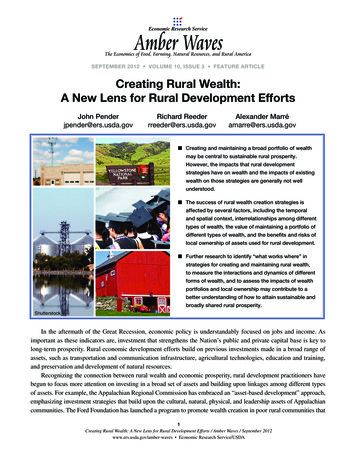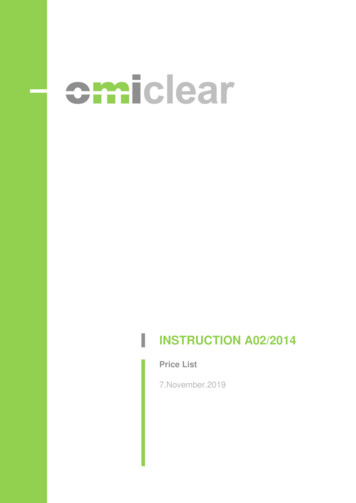Wealth Creation In Rural Communities - NADO
Wealth Creation in Rural Communities Presented by Wayne Fawbush, The Ford Foundation Melissa Levy, Yellow Wood Associates
Questions we are ALL asked/asking What do we actually do? Where do we find the resources? How will we know if our work is successful? Who will actually benefit? How is the effort sustained over time?
Ford Foundation Intent To have a positive impact on high-poverty communities in rural America by using a systems approach to wealth creation.
Why a Systems Approach? Systems approach connects practitioners at the community level and makes resource providers more effective by focusing work on common goals/interests.
Guiding Principles of a Systems Approach Wealth is created and “sticks” in low wealth rural areas. Wealth is tied to place by value chains developed within sectors. Wealth-based development is demand driven. Measurement is integrated into the entire process. Investment fuels wealth creation. Strategically flexible while doing no harm.
A Value Chain is A business model based on shared economic, social, and environmental values, Buyers, processors, producers and others work together for mutual benefit to create value in response to market demand.
Value Chains vs. Supply Chains Traditional Supply Chain Wealth Creation Value Chain Chain starts with producer supply Chain starts with consumer demand Measured by net income produced Measured by wealth created/retained Everyone is in it for him/herself Everyone is in it together Power determines who gets paid how much for their role Intentionally balances mutual benefit of all in chain Participants try to pass on costs to others within or outside of chain All known costs are considered and addressed Tries to influence policy to create advantage and maximize short-term income Tries to influence policy to level the playing field and maximize long-term and widely shared wealth
Why use a Wealth Creation framework? The wealth creation approach is an antidote to the extraction of wealth and the exploitation of resources to which poor rural areas have long been subjected.
What do we mean by “Wealth?” Seven Forms of Wealth Intellectual capital Political capital Natural capital Social capital Built capital Individual capital Financial capital Creating wealth that sticks is rarely an intentional goal, even when we define wealth broadly.
Understand the difference between wealth and income Most projects focus on income (a flow) instead of on building wealth (a stock). INCOME WEALTH EXPENSE
A wealth matrix for planning and evaluation Type of Wealth Interventions in Value Chains Individual How will your intervention impact the stock of skills and physical and mental healthiness of people in a region? Social How will your intervention impact the stock of trust, relationships, and networks that support civil society? Intellectual How will your intervention impact the stock of knowledge, innovation and creativity? Natural How will your intervention impact the stock of unimpaired environmental assets in a region Built How will your intervention impact the stock of fully functioning constructed infrastructure? Political How will your intervention impact the stock of power and goodwill held by individuals, groups, and/or organizations? Financial How will your intervention impact the stock of unencumbered monetary assets at the individual and community level?
The Wealth Creation Approach Results Value Chain Social Capital Intellectual Capital Interventions Interventions Interventions Interventions Supply Chain Individual Capital Natural Capital Built Capital Financial Capital Political Capital
Wealth Matrix Type Individual Social Intellectual Natural Built Financial Political Intervention Indicator Measure Baseline Method
Measuring Individual Capital Central Appalachian Network Indicator: more and improved best practices skills by farm and food producers Measures: number of producers selling into wholesale value chains, amount of sales, relationships between producers and buyers Framing measure: number of producers selling into wholesale value chains and amount of sales at a greater scale
Measuring Individual Capital Central Appalachian Network Number of Producers 133 140 120 100 96 80 60 40 20 0 Baseline Year One Year Two Year Three Year Four
Measuring Natural Capital Central Appalachian Network Indicator: increased acreage of sustainable production going into value chains Measures: acreage of sustainable production contributing to value chains, degree of sustainability Framing measures: acreage of sustainable production in the region, acreage of prime agricultural soils.
Measuring Natural Capital Central Appalachian Network 3500 3000 Certified Organic Acres 2500 2000 Moving Towards Certification 1500 Chemical Free, Uncertified 1000 Other/Unspecified 500 0 Baseline Year One Year Two
Measuring Natural Capital Rural Action Intervention: Growth of certified acres as a result of the Appalachian Carbon Partnership. Indicator: Improved forest ecosystem health. Measure: Number of landowners actively managing and acreage being actively managed. Baseline Measure: Number of certified acres in region.
Framing Measure Rural Action
Lessons This process is not designed to be extractive. This way of measuring should help groups do their work more effectively. Measurement does not just happen; it needs to be intentional and well considered.
Where are we working on the ground? Value chain construction with partners in Central Appalachia Energy efficient housing, energy efficiency, food, forestry Value chain exploration and selected construction grants with partners in the Alabama Black Belt and Mid-South Renewable energy, investment, forestry, food, community-based tourism Value chain exploration grants in the Lower Rio Grande Valley region in Texas Green housing/neighborhoods, literacy
Acknowledgements Thank you to CAN and Rural Action for their contributions to this presentation. Learn more about their work on their websites: CAN: http://www.cannetwork.org/ Rural Action: http://ruralaction.org/
For More Information Please visit: www.creatingruralwealth.org and http://www.yellowwood.org/wealthcreation.aspx Join the National Community of Practice at www.ruralwealth.org Or contact: Wayne Fawbush The Ford Foundation w.fawbush@fordfound.org Melissa Levy Yellow Wood Associates 802-524-6141 melissa@yellowwood.org
Wealth is created and "sticks" in low wealth rural areas. Wealth is tied to place by value chains developed within sectors. Wealth-based development is demand driven. Measurement is integrated into the entire process. Investment fuels wealth creation. Strategically flexible while doing no harm.
In this overview, we briefly define the concepts of "wealth" and "wealth creation", explain why a focus on wealth creation is important, discuss recent efforts to promote rural wealth creation, discuss what is known from past research about rural wealth creation, and introduce a conceptual framework for rural wealth creation and the theme
This research was supported by The Ford Foundation's Wealth Creation in Rural Communities - Building Sustainable Livelihoods initiative. The grant for the project came through the Center for Rural Entrepreneurship. To download a copy of this report: Visit the Wealth Creation in Rural Communities -
Wealth Creation in Rural America This report is part of the Wealth Creation in Rural America initiative, funded by the Ford Foundation. The aim of the initiative is to help low-wealth rural areas over-come their isolation and integrate into regional economies in ways that increase their ownership and influence over various kinds of wealth. The .
Creating and maintaining a broad portfolio of wealth may be central to sustainable rural prosperity. However, the impacts that rural development strategies have on wealth and the impacts of existing wealth on those strategies are generally not well understood. The success of rural wealth creation strategies is
Wealth Creation Principles To achieve wealth in your life and in your business, you need to follow certain principles that make up the Wealth Creation mindset. We outline 20 of these principles below and we pray that these principles find you well. 20 Principles of Wealth Creation to help develop your mindset. 1. Study Wealthy People
1.2 The Scope of our Wealth Management Services 1.3 Components of Wealth Management 1.4 Process of Wealth Management 1.5 Need for Wealth Management 1.6 Expectation of Clients 1.7 Challenges to Wealth Management in India 1.8 Code of Ethics for Wealth Managers 1.9 Review Questions 1.1 Introduction to Wealth Management What is 'Wealth Management'?
Case Studies of Wealth Creation and Rural-Urban Linkages 8 1.2 The Key Concepts Sustainable Livelihoods The Ford Foundations Wealth Creation in Rural Communities initiative is itself part of the Foundation [s Expanding Livelihood Opportunities for Poor Households program, in which livelihoods are defined as: the ability to earn an income that enables the individual or the household to overcome
OMIClear Instruction A02/2014 Price List Versions Index 11.Apr.2014 Initial version. Revokes OMIClear Notice 03/2010 – Price List. 1.Feb.2015 Modification of the Price List, including: modification of the structure regarding the Fees on transactions in Futures, Forwards and Swaps .which depend on the monthly traded volume (now including 3 tiers of volume instead of 2). Clarification on the .






















